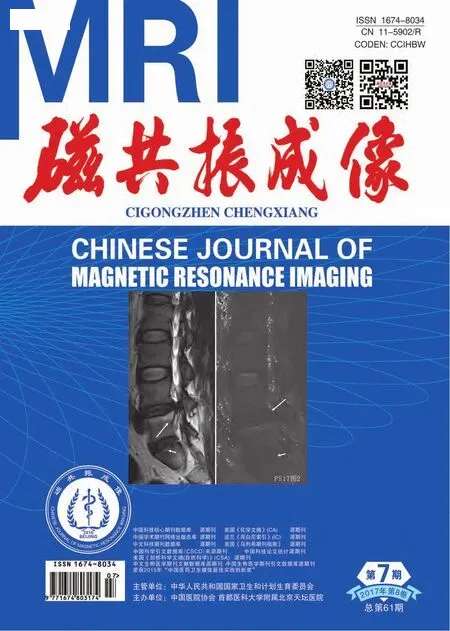CE-MRV显示静脉窦形态与眼压关系的研究
梁英良,王嵩,姚晔
CE-MRV显示静脉窦形态与眼压关系的研究
梁英良,王嵩,姚晔*
目的以增强磁共振静脉造影(contrast-enhanced MR venography,CEMRV)为检查方法,显示静脉窦的形态,明确横窦形态的不对称性与左、右眼之间的眼压是否存在相关的联系。材料与方法入组志愿者包括53名男性和52名女性自愿者。有过明显神经疾患、眼病、静脉血栓、青光眼排除在外。受检者根据MRV扫描直窦的形态分为五组。组Ⅰ:L>>R左侧明显大于右侧;组Ⅱ:L>R左侧大于右侧;组Ⅲ:L=R左侧与右侧相近;组Ⅳ:L<R左侧小于右侧;组Ⅴ:L<<R左侧明显小于右侧。志愿者的眼压在检查前被分别测定。结果组Ⅰ、Ⅱ与组Ⅴ之间有统计学意义(P<0.05)。各组的眼内压中,左、右眼均值之间,差异有统计学意义(P=0.04)。横窦的不对称性和右眼内压值(r=0.51,P<0.01),呈负相关的关系;横窦的不对称性和左眼内压值没有统计学相关性(r=0.32,P=0.09)。结论左、右眼的眼压与横窦形态存在一定的联系。右侧的横窦形态越粗,其引流的静脉压力较低,同侧的眼压也越低。
横窦;高眼压;低眼压;磁共振成像
凡是不引起视功能和眼球组织损害的眼压水平可以认为是正常眼压,其正常范围值为10~21 mm Hg,标准差为3 mm Hg[1]。正常人双眼眼压存在一定的差异,并且有时这种差异性较大[2]。如何解释这种差异性?通过临床的观察,静脉窦血栓的主要症状与静脉回流受阻引起的颅高压有关,表现为头痛、呕吐、视乳头水肿、复视等[3];在一定意义上说明,静脉窦的引流与眼部压力及眼部静脉引流存在一定的相关性[4]。在解剖学上,房水的产生与引流渠道都与眼部的静脉相关,能否以这种不对称性来解释眼压的差别,进而针对早期的眼压增高及正常眼压的变异进行甄别。笔者假设这种不对称性可以用横窦之间的解剖不对称来解释,即如果双侧横窦之间存在着不对称性可能导致双侧眼压之间的不对称。本研究以CEMRV为检查手段显示横窦的形态并用以论证假设是否成立。
1 材料与方法
1.1 志愿者
本研究中共包括53名男性和52名女性志愿者,24~66岁。受试的志愿者中有过神经疾患、眼病、静脉血栓、青光眼排除在外。受检者根据MRV扫描横窦形态分为五组,组Ⅰ:L>>R左侧明显大于右侧;组Ⅱ:L>R左侧大于右侧;组Ⅲ:L=R左侧与右侧相近;组Ⅳ:L<R左侧小于右侧;组Ⅴ:L<<R左侧明显小于右侧(图1)。
1.2 测量标准
左、右侧比值在0.8~1.2之间定义为组Ⅲ(L=R),左、右侧比值>1.2 而<1.5定义为组Ⅱ,右、左侧比值大于1.2而<1.5定义为组Ⅳ,左右侧比值大于1.5以上定义为组Ⅰ,右左侧比值大于1.5以上定义为组Ⅴ。
1.3 图像采集
1.5T Simens Avanto扫描仪,扫描包括常规序列T1WI、T2WI、FLAIR、DWI及增强后3D-T1WI序列。扫描参数,T1WI:FOV 28 cm×28 cm,TR 550 ms,TE 10 ms,ETL为3,矩阵256×192;T2WI:FOV 28 cm×28 cm,TR 6000 ms,TE 104 ms,ETL为24,矩阵288×190;FLAIR:TR 2680 ms,TE 60 ms,IR 2000,矩阵256×192;DWI:FOV 28 cm×28 cm,TR 5000 ms,TE 60 ms,矩阵128×96,30 s;3D-T1WI:TR 550 ms,TE 10 ms,反转角25°;FOV 24 cm×24 cm,slice=180,体素0.8 mm×0.8 mm×0.8 mm。扫描结束后以MIP重建模式后处理,层厚为25 mm。
1.4 眼压的测定
专用眼压仪(TOPCON CT80A)测定眼内压,共测量三次取三次的平均值。测定的眼压值与MRV分型结果分离双盲分析。
1.5 统计学分析
使用SAS v8.12 统计分析软件,对各组之内的左眼和右眼的眼压值及左、右眼压之间进行配对样本的t检验,组间的比较采用单因素方差分析。对横窦形态的不对称性(左右比值)和两眼的眼压值分别进行Pearson相关分析,P<0.05认为存在统计学意义。
2 结果
根据MRV所示静脉窦形态分组情况和各组所测得横窦的数值见表1 (图1)。
表2所示的是在不同组间的平均眼内压值,平均值为15 mm Hg,区间为12~20 mm Hg。各组志愿者的眼内压均在正常值内。各组的眼内压中,左、右眼均值之间,差异具有统计学意义(P=0.04)。组间的比较:组Ⅰ、组Ⅱ、组Ⅴ之间存在统计学意义(组Ⅰ、Ⅱ比较:F=7.17,P<0.01;组Ⅰ、Ⅴ比较:F=8.11,P<0.01;组Ⅱ、Ⅴ比较:F=5.29,P<0.01)。

表1 根据MRV所示静脉窦形态分组和各组所测得横窦结果(x±s)Tab. 1 According to the MRV shown in sinus morphology group and the measured results of each transverse sinus (x±s)

表2 不同组别左、右眼眼压统计结果(mm Hg,x±s)Tab. 2 Intraocular pressure of left and right eyes in different groups (mm Hg, x±s)
横窦的不对称性的程度(左右横窦测量的比值)和右眼内压值呈负相关的关系(r=0.51,P<0.01);横窦的不对称性的程度和左眼内压值没有相关性(r=0.32,P=0.09)。

图1 组Ⅰ~Ⅴ磁共振重建MIP图像。A:组Ⅰ,L>>R左侧明显大于右侧,左右比值大于1.5;B:组Ⅱ,L>R左侧大于右侧,左、右侧比值>1.2 而<1.5;C:组Ⅲ,L=R左侧与右侧相近,左、右比值0.8~1.2;D:组Ⅳ,L<R左侧小于右侧,右、左侧比值大于1.2而<1.5;E:组Ⅴ,L<<R左侧明显小于右侧,右左比值大于1.5Fig. 1 Group Ⅰ—Ⅴ MRI of the MIP. A: Group Ⅰ, L>>R showed the left significantly larger than the right side. B: Group Ⅱ, L>R, left side is larger than right. C: Group Ⅲ, L=R, left and right is similar. D: Group Ⅳ, L<R, left side is smaller than the right. E: Group Ⅴ, L<<R the left significantly smaller than the right side.
3 讨论
眼内压主要决定因素是房水的产生与引流即房水动力学和眼部的生理功能周期[5-7]。眼部的睫状体中睫状突毛细血管的非色素上皮细胞分泌产生房水,进入后房后越过瞳孔到达前房,再从前房的小梁网进入Schlemm管,然后汇入巩膜表面的睫状前静脉,回流到血循环[8]。眼部静脉最大的特点在于没有静脉瓣,其引流的速度与压力直接决定于汇入的大静脉。眼部静脉主要分深静脉与浅静脉,主要汇入海绵窦,而海绵窦向后经岩上窦与乙状窦或横窦相交通,经岩下窦与乙状窦或颈内静脉相交通[9]。笔者的假设也正是基于眼部静脉的生理解剖学的特征,无静脉瓣以及引流的方向。解剖学上一般右侧横窦大于左侧者较多[10],与本研究结果(即右侧横窦占优势者为总数的73/105)相符合。
Igarashi等[11]报道一例左侧横窦静脉血栓的患者,其左侧眼压明显增高(24 mm Hg),右侧眼压却正常(17 mm Hg),间接地证实了本研究假设的合理性。
本研究中各组间左眼、右眼以及左右眼眼压的差值存在统计学意义。另外双侧横窦形态不对称性与右侧眼压及双侧眼压之间呈负相关的关系。但并未发现横窦形态不对称性与左侧眼压之间存在相关。从中我们可以看出横窦不对称与眼压的关系,即右侧横窦越大,眼压就越低。除了IV组外各组内左、右眼眼压也存在统计学差异,这说明左、右眼之间也存在着不对称性。而这种不对称性可以用横窦之间的不对称来解释,即如果双侧横窦之间存在着不对称性可能导致双侧眼压之间的不对称。Klysik等[12]曾经报道过右侧平均眼压低于左侧,从本研究的结果来看,由于右侧横窦大于左侧横窦的变异存在较多数人群中,眼压的差异性有可能是其中较为重要的因素之一。
眼压高于统计学上限,但缺乏可检测出的视盘和视野损害的临床指标及症状,临床上统称为高眼压或可疑青光眼。在40岁以上的人群中,约有7%的个体眼压超过21 mm Hg,大多数高眼压症经长期随访观察,并不出现视盘和视野损害,其中仅有大约10%的个体可能发展为青光眼,而且大多数发生在左眼[13]。本研究以3D-T1WI结合最大强度投影(maximum intensity projection,MIP)显示的方法,为其合理的解释提供了一种可行的检查手段。在MR成像技术中,时间飞跃法(time-of-flight,TOF)和相位对比法的血管成像也具有无创、无对比剂等优点,也曾经是热点研究的内容之一[14],但它的检查耗时长,需要患者的配合,易受血流形式和方向的影响而产生伪影,不能大范围显示靶血管。在本研究中为了获得良好的图像,采用了3D-T1WI扫描序列,扫描体素达到0.8 mm×0.8 mm×0.8 mm,同时本研究中采用了适中层厚的MIP重建,保证显示静脉窦的完整性。TOF技术对复杂血流显示能力较差,与TOF相比CEMRV显示静脉更加准确,但也存在缺点,因为其需要注射对比剂增加了检查费用,但在显示静脉窦的准确性方面较TOF提高,尤其在定量测量方面存在一定优势[15],所以本研究中采用CE-MRV的方法。对比剂增强的螺旋CT静脉血管成像(CT venography,CTV)和3D CE-MRV均属无创性检查,总体上相类似,但也存在不足之处[16]:(1)CTV不可避免产生离子辐射损伤;(2) CT上的骨骼、钙化灶或其它高密度灶的结构均会重叠遮盖血管,妨碍血管的显示;(3) MR检查采用的造影剂比CTV采用的碘对比剂安全的多,同时过敏反应要少的多。本研究的不足之处主要是没有研究早期眼压增高患者的左右静脉窦情况,在病理情况下尤其在早期眼压增高的疾病条件下的比较更具有临床意义。
本研究得出初步的结论,如果右侧横窦较粗大,其相应引流的眼静脉压力较低,眼压也相对较低。人群中正常眼压差值变异与横窦的形态可能存在一定的相关性;增强后CE-MRV检查可以作为检查手段显示横窦的形态,进而合理地证实本研究的结论。
[References]
[1] Cheng J, Kong X, Xiao M, et al. Twenty-four-hour pattern of intraocular pressure in untreated patients with primary open-angle glaucoma. Acta Ophthalmol, 2016, 94(6): e460-467.
[2] Abegão PL, Willekens K, Van Keer K, et al. Ocular blood flow in glaucoma-the leuven eye study acta ophthalmol. 2016, 94(6): 592-598.
[3] Tan JJ, Hassoun A, Elmalem VI. Cerebral venous sinus thrombosis with ophthalmic manifestations in 18-year-olds on oral contraceptives. Clin Pediatr (Phila), 2014, 53(9): 826-830.
[4] Herweh C, Griebe M, Geisbüsch C, et al. Frequency and temporal profile of recanalization after cerebral vein and sinus thrombosis. Eur J Neurol, 2016, 23(4): 681-687.
[5] Kiel JW, Hollingsworth M, Rao R, et al. Ciliary blood flow and aqueous humor production. Prog Retin Eye Res, 2011, 30(1): 1-17.
[6] Gulati V, Ghate DA, Camras CB, et al. Correlations between parameters of aqueous humor dynamics and the influence of central corneal thickness. Invest Ophthalmol Vis Sci, 2011, 52(2): 920-926.
[7] Zouache MA, Eames I, Samsudin A. Allometry and scaling of the intraocular pressure and aqueous humour flow rate in vertebrate eyes.PLoS One, 2016, 11(3): e0151490.
[8] Maślanka T. Autonomic drugs in the treatment of canine and feline glaucoma. Part II: Medications that lower intraocular pressure by reducing aqueous humour production. Pol J Vet Sci, 2014, 17(4):753-763.
[9] Ogle OE, Weinstock RJ, Friedman E. Surgical anatomy of the nasal cavity and paranasal sinuses. Oral Maxillofac Surg Clin North Am,2012, 24(2): 155-166.
[10] Mogicato G, Raharison F, Ravakarivelo M, et al. Normal nasal cavity and paranasal sinuses in brown lemurs eulemur fulvus: computed tomography and cross-sectional anatomy. J Med Primatol, 2012,41(4): 256-265.
[11] Igarashi H, Igarashi S, Fujio N, et al. Magnetic resonance imaging in the early diagnosis of cavernous sinus thrombosis. Ophthalmologica,1995, 209(5): 292-296.
[12] Klysik A, Kaszuba-Bartkowiak K, Jurowski P. Axial length of the eyeball is important in secondary dislocation of the intraocular lens,capsular bag, and capsular tension ring complex. J Ophthalmol,2016, 2016: 6431438.
[13] Gao Z, Guo H, Chen W. Initial tension of the human extraocular muscles in the primary eye position. J Theor Biol, 2014, 353: 78-83.
[14] Zhang YQ, Li J, Xu L, et al. Anterior visual pathway assessment by magnetic resonance imaging in normal-pressure glaucoma. Acta Ophthalmol, 2012, 90(4): e295-302.
[15] Ho LC, Conner IP, Do CW, et al. In vivo assessment of aqueous humor dynamics upon chronic ocular hypertension and hypotensive drug treatment using gadolinium-enhanced MRI. Invest Ophthalmol Vis Sci, 2014, 55(6): 3747-3757.
[16] Vaid S, Vaid N. Normal anatomy and anatomic variants of the paranasal sinuses on computed tomography. Neuroimaging Clin N Am, 2015, 25(4): 527-548.
The study of relation between size of transverse sinus by MRV and pressure of eyes
LIANG Ying-liang, WANG Song, YAO Ye*
Department of Radioligy, Shanghai Longhua Hospital, Shanghai University of Traditional Chinese Medicine, Shanghai 200032, China
*
ACKNOWLEDGMENTSScientific Research Project of Shanghai Municipal Commission of Health and Family Planning (No. 201540198).
Objective:The purpose of this study was to investigate possible relationships between the asymmetry of transverse sinuses in CE-MRV and intraocular pressures of right and left eyes.Materials and Methods:In this study, subjects were 53 male and 52 female volunteers. Subjects with neurological and ophthalmologic disease,particularly dural sinus thrombosis, myopia, trauma and glaucoma, were excluded in the study. Subjects were divided into five groups according to the magnitudes of the rightand left-transverse sinuses in MR venography results. Group Ⅰ: L>>R. L significantly greater than R. Group Ⅱ: L>R, L greater than R. Group Ⅲ: L=R, the left and right sides are basically similar. Group Ⅳ: L<R, L smaller than R. Group Ⅴ: L<<R, L significantly smaller than R. The pressure of the eyes was been measured respectively.Results:The difference between percentages of subjects in group Ⅰ, Ⅱ and Ⅴ was statistically significant (P<0.05). The differences in the mean intraocular pressures of right and left eyes were statistically significant (P=0.04). There were inversePearsoncorrelations between asymmetry index of transverse sinus and intraocular pressure of the right eye(r=0.51,P<0.01), but was not significant correlation between asymmetry index of transverse sinus and intraocular pressure of left eye (r=0.32,P=0.09).Conclusions:There is a relation between intraocular pressures of the right and left eyes and asymmetry of the transverse sinus. If the right transverse sinus on one side is larger and its venous drainage is greater, the intraocular pressure of the eye on this side is lower.
Transverse sinuses; Ocular hypertension; Ocular hypotension; Magnetic resonance imaging
Yao Y, E-mail: 122186836@qq.com
Received 8 Feb 2017, Accepted 6 June 2017
上海市卫生和计划生育委员会科研课题(编号:201540198)
上海中医药大学附属龙华医院,上海200032
姚晔,E-mail:122186836@qq.com
2017-02-08
接受日期:2017-06-06
R445.2;R770.4
A
10.12015/issn.1674-8034.2017.07.005
梁英良, 王嵩, 姚晔. CE-MRV显示静脉窦形态与眼压关系的研究. 磁共振成像, 2017, 8(7): 505-508.< class="emphasis_italic">Correspondence to: Yao Y, E-mail: 122186836@qq.com

